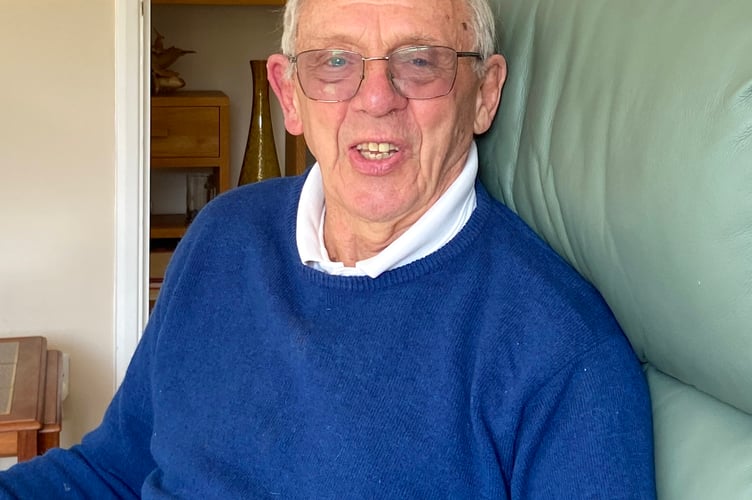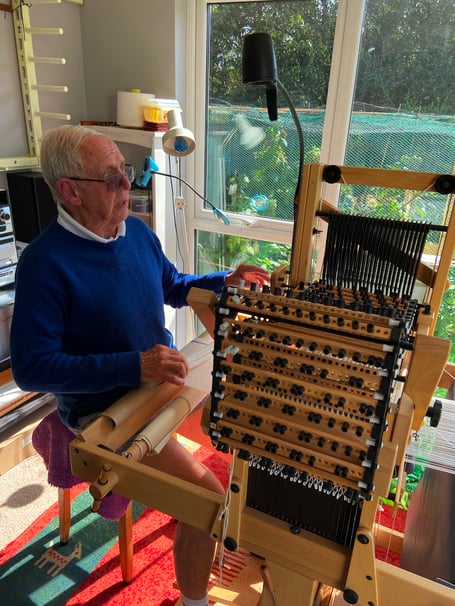Malcolm Weir may be 85 but this Chillington resident is almost as active as he was when he started working in the fashion industry exactly 70 years ago. Richard Torne met him at his home near Kingsbridge, finding out why he is keen to pass on his weaving skills to younger generations and why the ancient craft has a crucial role to play even today.
The repetitive, threading-weaving motion has a calming, almost hypnotic effect. “The process itself is relatively simple, but you need total concentration,” he explains.
To the uninitiated, weaving essentially involves interlacing two different sets of yarns or threads at right angles to form a fabric or cloth, but for Malcolm Weir it’s a lot more than that.
Few would argue that weaving is a dying art. Almost as ancient as civilised man, the craft has in some form or another been around for tens of thousands of years and played a dominant role in almost every major civilisation from China in the Far East to the Incas in South America.
In the latter’s case, textiles were also used as the primary means of conveying both images and ideas.
The industrial revolution gave weaving new impetus, but today, due to modern production methods and cheap Far East imports, traditional weaving seems destined to disappear.
Commercial considerations aside, the general perception around weaving is that it’s a bit of a historical curiosity, a whimsical glimpse into our more sedate past, but nothing more.
Malcolm strongly disagrees, but fully understands why that would be the case.
“Weaving in this country was a dying tradition in this country. It’s gone as low as it’s possible to go. There are very few commercial mills left in the UK,” he says resignedly.
And it’s not just weaving that appears to be in terminal decline. Spinning, dyeing and finishing, all part and parcel of a process that goes all the way back to farmers, seem consigned to the history books.

“Today it costs farmers more to shear the sheep than they can get for the fleece.”
Changes in fashion have also played a part. “Young men stopped wearing woollen sports coats and jackets, and started wearing anoraks and fleeces...chinos and jeans, all of which use polyester cotton and are made abroad.”
Malcolm’s love for weaving and the wider sector remains undiminished, however. After leaving school at the tender age of 15, in 1953, he went to work as an apprentice in a textile mill in Carlisle, where he grew up.
He spent 18 months manually dyeing the wool in huge vats, stirring them with large wooden paddles, and setting up power looms; the clanging mechanised devices one might associate with 19th century factories and Dickens’ novels.
But instead of being horrified by the experience, he embraced his surroundings with gusto, and rejects suggestions that it was a physically demanding job.
“I did not find it like that. Part of the reason is that I didn’t enjoy school at all!’ he laughs. “I was fit because of all the sport I did. I realised early on how much I enjoyed the creative side of weaving and that not all children are academically inclined. A lot of them are better with their hands and are very creative given half a chance.”
Weaving satisfied Malcolm’s creative bent, and he spent the two last years of his apprenticeship in the design department. It set the tone for what was to come.
He started designing cotton pyjamas, shirts, scarves, rugs and outer wear. It meant retreating into an office, which would not have been his first choice, such was the allure of working on power looms on the shop floor.
His career nonetheless took off and later he worked on women’s fashion in Dublin, becoming solely responsible for the company’s design collection. “That was very challenging – I was the one carrying the can at the end of the day.”
Much like today, fashion trends were largely dictated by French fashion houses, but that didn’t prevent Malcolm from adding a personal touch to designs.
“You always tried to change it slightly because you knew everyone else would do it exactly the same.”
He was awarded seven design medals in the US along the way, although to this day he doesn’t know exactly for what. “We never got an answer to that!”
In 1996, he returned to the UK and moved to Kingsbridge, where the discovery of an abandoned handloom in a shed in Torr Quarry rekindled his interest in weaving.
He began attending craft fairs and selling in local shows, where he was approached by people keen to take up weaving as a hobby. Unsurprisingly, given the higher skillset needed to teach weaving compared to knitting, there were few teachers around, so Malcolm stepped up to the plate.
There is however another reason why Malcolm believes weaving should play a bigger role in people’s lives.
“I started to read about how so many older people live alone and are lonely. There’s a very large social aspect to it if you want to involve yourself. Mental wellbeing comes into play, too.”
He recalls one German lady with health issues who signed up to one of his courses, saying weaving formed part of her health service treatment back in Germany.
By contrast, funding has stopped for similar courses in the UK, although this hasn’t stopped NHS experts approaching him at shows asking him to help people with mental health issues.
“I can tell you absolutely categorically that once you start to weave at a loom everything else goes, because you need total concentration.”
It’s not just older people who can benefit, in his view. He is now spreading the word in local schools to show younger generations what they’re missing. “If you go by the schoolchildren, they are as enthusiastic to do it as older people.”
His enthusiasm is infectious – as this hack can readily attest – and at shows he reaches out, convincing people to have a quick go on a loom. “It’ll take 10 minutes to show them how to do it, and I them leave them to get on with it!”
Five years ago during a trip to Tibet to celebrate his 80th birthday, he stumbled upon a number of disused looms, which had been intended to be used to manufacture tents for Chinese tourists.
True to form, Malcolm set about fine tuning the machines. “What they were weaving was basically rubbish. The threads were criss-crossed instead of running parallel. I took a comb out of my pocket and combed the threads to untangle them.”
The irony of a retired westerner going to the Far East to start up a textile production line cannot be understated, but despite recent history, weaving in the UK could enjoy a renaissance of sorts in a commercial sense, too.
As with luxury cars and other high-end products, weaving might be another sector that could thrive as it caters for people seeking bespoke, expensive goods.
In fact, some of the scarves that Malcolm weaves sell for around £50, and there’s no shortage of customers, which is just as well. As he likes to point out, he’s not ready to hang up his loom just yet.
“If the weather’s good I’m out, if the weather’s bad I’m weaving.”





Comments
This article has no comments yet. Be the first to leave a comment.